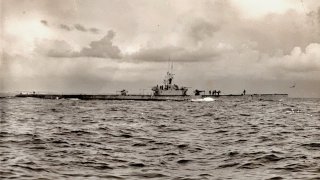USS Bullhead: The Last U.S. Navy Submarine Lost in Combat
The USS Bullhead (SS-332), a Balao-class diesel-electric submarine, was the last American submarine lost in combat. Sunk by Japanese aircraft off Bali on August 6, 1945, the same day Hiroshima was bombed, Bullhead's crew of 84 perished.
Summary and Key Points: The USS Bullhead (SS-332), a Balao-class diesel-electric submarine, was the last American submarine lost in combat. Sunk by Japanese aircraft off Bali on August 6, 1945, the same day Hiroshima was bombed, Bullhead's crew of 84 perished.
-The submarine's radar range was likely hindered by Bali's coastal geography, preventing timely detection of the enemy. Bullhead, commissioned in December 1944, was equipped with torpedo tubes, deck guns, and anti-aircraft guns, making it a formidable opponent.
-The submarine had a range of 11,000 nautical miles and served effectively in the Pacific Theater until its tragic end.
The Last US Submarine to Be Lost in War
There’s nothing worse than getting killed. Well, perhaps getting killed on the last day of a war that your country won. That’s precisely what happened to the U.S. Navy’s Balao-class diesel-electric submarine USS Bullhead (SS-332), in the Pacific Theater of the Second World War.
This boat was destroyed by Japanese aircraft off the coast of Bali, near the northern end of the Lombok Strait, on the same day that the U.S. Army Air Corps dropped a nuclear bomb on Hiroshima.
In fact, Bullhead was the last American submarine lost in combat.
The sub was sunk by a Japanese aircraft dropping depth charges. Eighty-four crewmen were killed. An after-action report details how the geography of the Bali coast itself may have played a critical role in the destruction of Bullhead. The coast and surrounding mountainous terrain likely shortened the American submarine’s radar range, preventing the boat from detecting the approaching enemy aircraft in time to dive to safety.
Bullhead was a diesel-electric submarine, which meant that it had a diesel engine for surface propulsion and battery-operated electric motors for underwater propulsion. This combination allowed the submarine to operate efficiently both on the surface and when submerged, making it a versatile and effective platform in the Navy’s expansive arsenal against the Japanese Empire.
While the Navy has since moved away from diesel-electric submarines and embraced the more efficient (and expensive) nuclear-powered submarines, many nations today, including rival great powers such as China and Russia, continue to employ diesel-electric submarines to great effect.
Bullhead had a crew of approximately 80 to 100 officers and enlisted men. This relatively large crew size allowed the submarine to operate effectively for extended periods at sea, conducting patrols and engaging in combat operations.
Bullhead was equipped with ten 21-inch torpedo tubes (six forward and four aft), one 5-inch deck gun, one 40mm anti-aircraft gun, and one 20 mm anti-aircraft gun. This array of weapons made the submarine a formidable adversary against surface ships and aircraft.
USS Bullhead had a range of about 11,000 nautical miles and could reach cruising speeds up to 10 knots. Considering the vastness of the Pacific Ocean, this extended range capability made the Balao class a worthwhile investment for the Navy. Bullhead was a prime platform for the War in the Pacific.
SS-332 was built by the Electric Boat Company in Groton, Connecticut, and was commissioned on December 4, 1944. It was one of the last Balao-class submarines to be built during the war.
Its loss was a tragedy. That it came basically on the last day of the war is doubly sad.
Author Experience and Expertise: Brandon J. Weichert
Brandon J. Weichert, a National Interest national security analyst, is a former Congressional staffer and geopolitical analyst who is a contributor at The Washington Times, the Asia Times, and The-Pipeline. He is the author of Winning Space: How America Remains a Superpower, Biohacked: China’s Race to Control Life, and The Shadow War: Iran’s Quest for Supremacy. His next book, A Disaster of Our Own Making: How the West Lost Ukraine, is due October 22 from Encounter Books. Weichert can be followed via Twitter @WeTheBrandon.
All images are Creative Commons or Shutterstock.
From the Vault
Russia Freaked Out: Why the U.S. Navy 'Unretired' the Iowa-Class Battleships
Battleship vs. Battlecruiser: Iowa-Class vs. Russia's Kirov-Class (Who Wins?)

